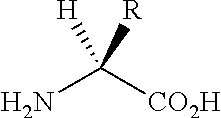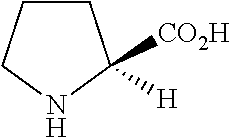Salt-resistant emulsions
- Summary
- Abstract
- Description
- Claims
- Application Information
AI Technical Summary
Benefits of technology
Problems solved by technology
Method used
Image
Examples
example 1
Preparation of Emulsions Using Peptide SEQ ID NO: 1. Effects of Sodium or Potassium Chloride
[0112]A series of emulsions was prepared by sonicating aqueous solutions of 1 mM SEQ ID NO: 1, 0.0-2.0 M NaCl or KCl, pH 6.0, with 20% (v / v) hexadecane. Samples of the emulsions were diluted in the corresponding salt solution and the droplet size distribution and zeta potential were determined using a Zetasizer Nano ZS. The Sauter mean diameter and zeta potential at selected salt concentrations are given in Table 6 Larger droplet sizes indicate flocculation and / or coalescence of droplets in the emulsion. It can be seen that sensitivity to high salt concentrations is greater with NaCl than KCl for this peptide emulsifier.
TABLE 6Effect of salts on the Sauter mean diameterof droplets in emulsions prepared with 1 mMSEQ ID NO: 1 pH 6.0 and 20% (v / v) hexadecane.Salt Concentrationd32 (nm)Zeta potential (mV)0 mM (KCl)374−62.8100 mM (KCl)314−37.2200 mM (KCl)515−37.7500 mM (KCl)569−24.41.0M (KCl)543−16...
example 2
Preparation of Emulsions Using Peptide SEQ ID NO: 3. Effects of Sodium or Potassium Chloride
[0113]A series of emulsions was prepared by sonicating aqueous solutions of 1 mM SEQ ID NO: 3, 0.0-2.0 M NaCl or KCl, pH 9.0, with 20% (v / v) hexadecane. Samples of the emulsions were diluted in the corresponding salt compositions and the droplet size distribution was determined using a Zetasizer Nano ZS. The zeta potential was determined after dilution in water. The Sauter mean diameter and zeta potential at selected salt concentrations are given in Table 7. Larger droplet sizes indicate flocculation and / or coalescence of droplets in the emulsion. It can be seen that sensitivity to high salt concentrations is similar with NaCl and KCl for this peptide emulsifier.
TABLE 7Effect of salts on the Sauter mean diameter and zetapotential of droplets in emulsions prepared with 1mM SEQ ID NO: 3 pH 9.0 and 20% (v / v) hexadecane.Salt Concentrationd32 (nm)Zeta potential (mV)0 mM (KCl)243−69.620 mM (KCl)236...
example 3
Dilution of Emulsions Prepared Using Peptide SEQ ID NO: 7 in Salt Solutions. Effects of Sodium, Potassium or Calcium Chloride
[0114]An emulsion was prepared by sonicating an aqueous solution of 1 mM SEQ ID NO: 7 pH 6.0 with 20% (v / v) hexadecane. Samples of the emulsion were diluted in different salt compositions and the droplet size distribution was determined using a Zetasizer Nano ZS. The Sauter mean diameter at selected salt concentrations is given in Table 8. Larger droplet sizes indicate flocculation and / or coalescence of droplets in the emulsion. It can be seen, that an emulsion prepared at low salt concentrations with this peptide tolerates subsequent dilution in high concentrations of sodium, potassium or calcium chloride, but is more sensitive to sodium than to potassium chloride.
TABLE 8Effect of dilution in different salt solutions on the Sautermean diameter of droplets in an emulsion prepared with1 mM SEQ ID NO: 7 pH 6.0 and 20% (v / v) hexadecane.Diluentd32 (nm)No added sal...
PUM
| Property | Measurement | Unit |
|---|---|---|
| Fraction | aaaaa | aaaaa |
| Mass | aaaaa | aaaaa |
| Mass | aaaaa | aaaaa |
Abstract
Description
Claims
Application Information
 Login to View More
Login to View More - R&D
- Intellectual Property
- Life Sciences
- Materials
- Tech Scout
- Unparalleled Data Quality
- Higher Quality Content
- 60% Fewer Hallucinations
Browse by: Latest US Patents, China's latest patents, Technical Efficacy Thesaurus, Application Domain, Technology Topic, Popular Technical Reports.
© 2025 PatSnap. All rights reserved.Legal|Privacy policy|Modern Slavery Act Transparency Statement|Sitemap|About US| Contact US: help@patsnap.com



